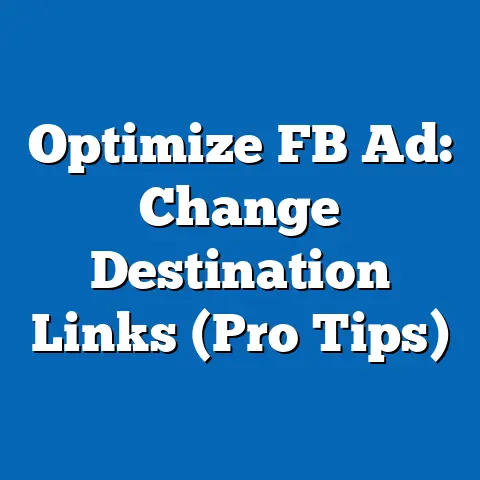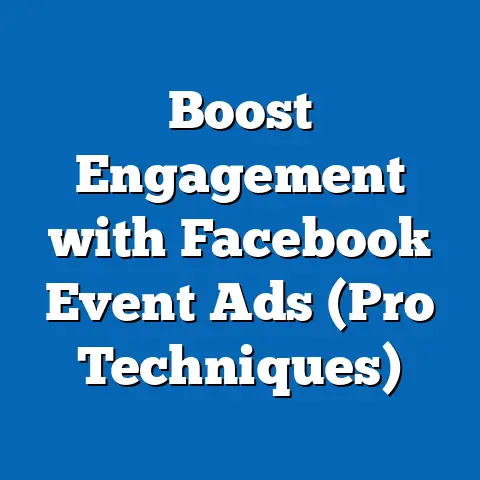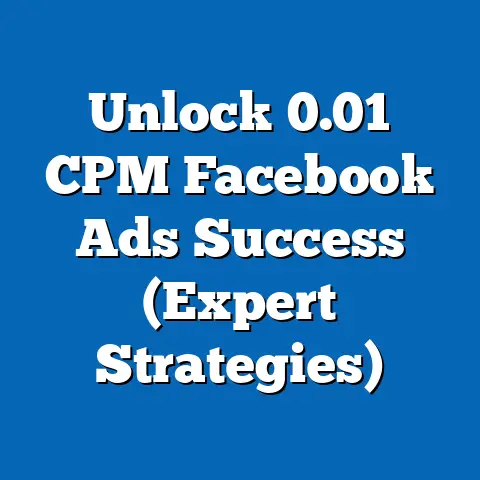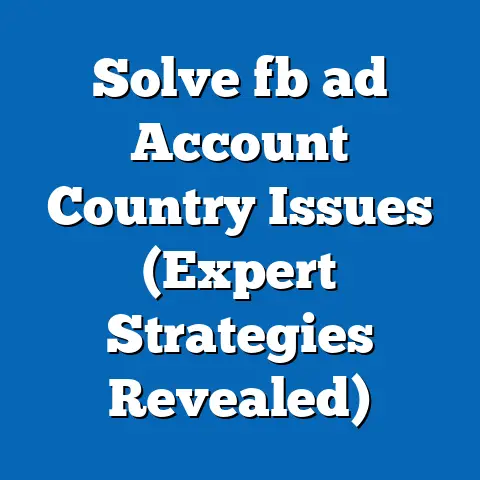Can News Publishers Profit on Facebook? (Maximize ROI Today)
“Facebook used to be a goldmine for driving traffic to our articles, but now it feels like we’re shouting into a void,” says Maria Lopez, editor-in-chief of a mid-sized digital news outlet based in Chicago. Her sentiment echoes a growing frustration among news publishers who once relied on the social media giant to amplify their reach and revenue. However, the landscape has shifted dramatically, with algorithm changes, declining organic reach, and evolving user behaviors challenging the profitability of news content on the platform.
Recent data from Pew Research Center (2023) reveals that only 31% of U.S. adults now get their news from Facebook, down from a peak of 48% in 2017. Meanwhile, advertising revenue for publishers on the platform remains highly competitive, with a reported 62% of digital ad spend in 2022 captured by Meta (Facebook’s parent company), according to eMarketer. This article explores whether news publishers can still profit on Facebook, delving into key statistical trends, demographic breakdowns, historical shifts, and actionable strategies to maximize return on investment (ROI) in today’s environment. We will also project future opportunities based on emerging data and industry insights.
The Current State of News on Facebook: A Statistical Snapshot
Facebook remains a dominant force in digital media, with over 2.9 billion monthly active users worldwide as of Q2 2023, according to Meta’s quarterly earnings report. However, its role as a news distribution channel has waned significantly. A 2023 Reuters Institute Digital News Report found that only 22% of global respondents use Facebook as a primary news source, a sharp decline from 36% in 2016.
In the U.S., the drop is even more pronounced among younger demographics. Data from Statista (2023) shows that just 18% of adults aged 18-29 turn to Facebook for news, compared to 42% of those aged 50-64. This generational divide highlights a critical challenge for publishers: the platform’s news audience is aging, while younger users gravitate toward platforms like TikTok (43% of 18-29-year-olds use it for news) and Instagram (28%).
Advertising metrics further complicate the profitability picture. According to Social Media Examiner (2023), the average cost-per-click (CPC) for news-related ads on Facebook rose to $1.12 in 2022, up from $0.78 in 2019. Meanwhile, organic reach for publisher posts has plummeted to an average of 2.5% of followers, per Hootsuite’s 2023 Social Media Trends Report. These figures suggest that paid strategies are increasingly necessary, but the rising costs and shrinking engagement rates demand a more nuanced approach to ROI.
Demographic Breakdown: Who’s Still Reading News on Facebook?
Understanding the demographic composition of Facebook’s news audience is critical for publishers aiming to tailor content and ad strategies effectively. Let’s break down the data by age, gender, and geographic trends.
Age Demographics
As noted earlier, Facebook’s news audience skews older. Pew Research Center (2023) data indicates that 48% of U.S. adults aged 50 and older still rely on the platform for news at least occasionally, compared to just 18% of those aged 18-29. This gap has widened over the past five years, with a 10-percentage-point drop among the younger cohort since 2018.
This trend aligns with broader platform usage patterns. Statista (2023) reports that only 32% of U.S. teens aged 13-17 use Facebook regularly, down from 71% in 2015. For publishers, this means content strategies must either target older, more engaged users or pivot to cross-platform approaches to capture younger readers elsewhere.
Gender Differences
Gender differences in news consumption on Facebook are less stark but still notable. According to the Reuters Institute (2023), 33% of U.S. women report getting news from the platform, compared to 29% of men. Women are also more likely to engage with local news and lifestyle content, while men show a slight preference for political and breaking news stories, per a 2022 study by the American Press Institute.
These nuances suggest that publishers can optimize content by segmenting audiences and tailoring ad campaigns. For instance, hyper-local news targeting women aged 35-54 could yield higher engagement rates given their demonstrated interest.
Geographic Variations
Geographic trends reveal further disparities. In rural U.S. areas, 38% of adults still use Facebook as a primary news source, compared to 27% in urban centers, according to Pew Research (2023). Globally, Facebook remains a vital news platform in developing regions like Southeast Asia and Sub-Saharan Africa, where 41% of users cite it as a key news outlet, per the Reuters Institute (2023).
For publishers with international reach, these regional differences underscore the importance of localized content strategies. A one-size-fits-all approach to Facebook publishing is unlikely to maximize ROI across diverse markets.
Historical Trends: From Traffic Goldmine to Engagement Decline
To fully grasp the profitability challenges news publishers face on Facebook today, it’s essential to compare the current landscape with historical trends. Let’s trace the platform’s evolution as a news distribution channel over the past decade.
The Peak of Organic Reach (2012-2016)
In the early 2010s, Facebook was a traffic juggernaut for news publishers. A 2015 report from Parse.ly indicated that the platform drove up to 40% of referral traffic to news sites, outpacing even Google for many outlets. Organic reach during this period often exceeded 10-15% of a page’s followers, making it a cost-effective way to build audiences.
Publishers capitalized on this by prioritizing shareable, clickbait-style headlines and viral content. Revenue models were heavily tied to page views, with ad impressions generating significant income for digital-first outlets like BuzzFeed and Upworthy.
Algorithm Shifts and the Decline of News (2016-2020)
The turning point came in 2016 when Facebook began deprioritizing news content in favor of personal connections and “meaningful interactions.” Following criticism over misinformation during the 2016 U.S. election, the platform rolled out algorithm updates in 2018 that slashed organic reach for publishers to below 5%, according to a Social Flow analysis from that year.
By 2020, referral traffic from Facebook to news sites had dropped to just 20% of total external traffic, per Parse.ly data. Publishers were forced to pivot toward paid advertising, but even this became less effective as ad costs rose by 35% between 2017 and 2020, according to eMarketer.
The Current Era: Diversification and Paywalls (2021-Present)
Today, the reliance on Facebook for traffic has further diminished. Chartbeat data from 2023 shows that only 12% of news site traffic now comes from the platform, compared to 25% from direct visits and 30% from search engines like Google. Many publishers have shifted focus to subscription models, with 60% of top U.S. news outlets implementing paywalls by 2022, according to the Columbia Journalism Review.
This historical trajectory illustrates a clear lesson: dependence on Facebook as a primary traffic source is no longer viable. Publishers must adapt to a multi-channel reality where the platform serves as one piece of a broader revenue puzzle.
Contextual Factors Driving Facebook’s News Decline
Several external and internal factors have contributed to the declining profitability of news on Facebook. Understanding these dynamics is crucial for crafting effective strategies.
Algorithmic Prioritization of Non-News Content
Facebook’s algorithm now prioritizes content from friends, family, and entertainment over news. A 2021 internal Meta report, leaked to The Wall Street Journal, revealed that posts from news publishers were intentionally downranked to reduce polarization and misinformation. This shift has directly impacted engagement, with news posts seeing a 50% drop in interactions since 2018, per Hootsuite (2023).
User Behavior Changes
User preferences have also evolved. A 2023 survey by the Knight Foundation found that 54% of U.S. adults feel overwhelmed by the volume of news on social media, leading many to disengage. Additionally, trust in news shared on platforms like Facebook has declined, with only 27% of users believing content from publishers is credible, per Edelman’s 2023 Trust Barometer.
Competition from Other Platforms
Competing platforms like TikTok, Instagram, and YouTube have siphoned off younger audiences. eMarketer (2023) projects that TikTok will surpass Facebook in daily active users among Gen Z by 2025, with 48% of 18-24-year-olds already preferring short-form video for news updates. This fragmentation forces publishers to spread resources across multiple channels, diluting their focus on Facebook.
Economic Pressures on Publishers
Finally, the economics of digital publishing have tightened. With 70% of digital ad revenue in the U.S. captured by Google, Meta, and Amazon in 2022 (per Insider Intelligence), smaller publishers struggle to compete for ad dollars. Rising CPC costs on Facebook exacerbate this, making paid campaigns less sustainable without high conversion rates.
Strategies for Maximizing ROI on Facebook Today
Despite these challenges, opportunities remain for news publishers to profit on Facebook by adopting data-driven, targeted strategies. Below are actionable approaches grounded in current trends and research.
Leverage Paid Advertising with Precision Targeting
Given the decline in organic reach, paid ads are now essential. Social Media Examiner (2023) notes that publishers who segment audiences by demographics, interests, and behaviors achieve 30% higher click-through rates (CTR) than those using broad targeting. For example, a local news outlet could target ads to users within a 50-mile radius of their coverage area, focusing on age groups with high engagement (e.g., 35-54).
Additionally, retargeting campaigns can re-engage users who’ve visited a publisher’s site. Data from WordStream (2023) shows retargeted ads on Facebook have a 70% higher conversion rate compared to standard display ads. Publishers should allocate budgets toward these high-ROI campaigns.
Focus on Community Building and Engagement
Facebook Groups offer a way to bypass algorithm limitations by fostering direct engagement. A 2022 case study by Nieman Lab highlighted how The Washington Post grew a subscriber base of 15,000 through topic-specific Groups, driving a 25% uptick in paid subscriptions. Publishers can create niche communities around local issues, politics, or hobbies to build loyalty and drive traffic.
Interactive content also boosts engagement. Polls, live Q&As, and user-generated content prompts can increase interactions by 40%, per Sprout Social (2023). These tactics help publishers maintain visibility despite low organic reach.
Diversify Revenue Streams Beyond Ads
Relying solely on ad revenue from Facebook is risky. Publishers should explore alternative monetization, such as affiliate marketing or sponsored content within posts. For instance, a 2023 report by Digiday found that publishers integrating affiliate links in Facebook posts saw a 15% revenue boost per 1,000 impressions compared to standard ads.
Subscription drives are another avenue. By using Facebook to funnel users into email newsletters or paywalled content, publishers can build direct relationships. The New York Times reported a 20% increase in digital subscriptions in 2022 by promoting signup incentives via social ads.
Optimize Content for Mobile and Video
With 98% of Facebook users accessing the platform via mobile devices (Meta, 2023), content must be mobile-friendly. Short, snappy articles with bold visuals perform best, achieving 35% higher engagement rates than text-heavy posts, per Buffer (2023).
Video content is also critical. Native videos on Facebook garner 10 times more shares than links to external videos, according to Socialbakers (2023). Publishers should invest in creating 1-2 minute news clips optimized for silent autoplay (with captions) to capture attention in crowded feeds.
Statistical Comparisons Across Publisher Types
Not all news publishers experience the same outcomes on Facebook. Let’s compare performance metrics across different outlet types based on size and focus.
Large National Outlets vs. Small Local Publishers
Large national publishers like CNN and The New York Times maintain an edge due to brand recognition and larger ad budgets. Parse.ly (2023) data shows that top-tier outlets drive 18% of their traffic from Facebook, compared to just 8% for local news sites. However, local publishers often see higher engagement rates (3.5% vs. 1.8% for national outlets), as their content resonates more with niche audiences, per Hootsuite (2023).
Digital-First vs. Legacy Media
Digital-first publishers like Vox or BuzzFeed historically outperformed legacy media on social platforms. However, as organic reach declined, legacy outlets with established subscriber bases have adapted better, with 65% reporting subscription growth via social campaigns in 2022, compared to 40% for digital natives, per the Columbia Journalism Review. This suggests that trust and brand loyalty play a larger role in today’s environment.
Niche vs. General Interest
Niche publishers covering topics like technology or health often achieve better ROI on Facebook. A 2023 Digiday analysis found that niche outlets averaged a 4.2% engagement rate on posts, compared to 2.1% for general interest news. Targeted content aligns more closely with user interests, making it a viable strategy for smaller players.
Future Projections: Can Facebook Remain Viable for News Publishers?
Looking ahead, the outlook for news publishers on Facebook is mixed but not without potential. Industry forecasts and emerging trends provide a roadmap for navigating the platform’s evolving role.
Short-Term Challenges (2024-2025)
eMarketer (2023) projects that ad costs on Facebook will rise by another 10-15% by 2025, driven by increased competition and inflation. Organic reach is unlikely to recover, with Hootsuite forecasting a further decline to below 2% for publisher posts by 2024. Additionally, Meta’s focus on Reels and short-form video may further deprioritize traditional news formats.
Younger demographics will continue to migrate elsewhere. Statista (2023) predicts that Gen Z’s usage of Facebook will drop to 25% by 2025, with TikTok and Instagram capturing 60% of their attention. Publishers must prepare for an aging user base on the platform.
Long-Term Opportunities (2026-2030)
Despite these headwinds, some opportunities loom on the horizon. Meta’s investment in AI-driven content personalization could benefit publishers who create high-quality, relevant content. A 2023 report by Forrester suggests that AI-optimized ad targeting could improve CTRs by 20% over the next five years, potentially offsetting rising costs.
Moreover, Facebook’s global reach remains unmatched, especially in emerging markets. The Reuters Institute (2023) forecasts that news consumption on the platform in regions like Africa and Asia will grow by 8% annually through 2030, driven by mobile internet penetration. Publishers with international strategies can tap into these growth areas.
Implications for Publishers
The future of profitability on Facebook hinges on adaptability. Publishers must balance paid and organic strategies, diversify revenue beyond ads, and invest in cross-platform presence to mitigate risks. Those who fail to innovate may see diminishing returns, while agile outlets leveraging data and community-building could carve out sustainable models.
Conclusion: Navigating a Complex Landscape
Maria Lopez’s frustration with Facebook reflects a broader reality: the platform is no longer the traffic engine it once was for news publishers. With organic reach at historic lows, ad costs rising, and younger audiences drifting to competitors, profitability requires a strategic rethink. Yet, as data shows, targeted advertising, community engagement, and diversified revenue streams offer pathways to maximize ROI.
Historically, publishers who over-relied on Facebook suffered when algorithms shifted, and current trends suggest that diversification is non-negotiable. Looking forward, while challenges persist, opportunities in personalized targeting and global markets provide hope. By blending data-driven tactics with innovative content, news publishers can still profit on Facebook—but only if they adapt to a landscape that demands precision, creativity, and resilience.






